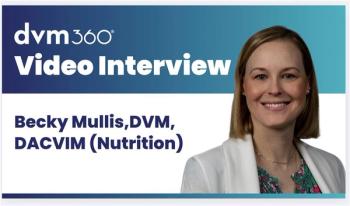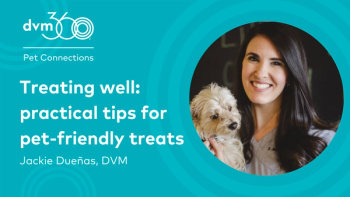
The nutritional assessment (Proceedings)
Nutrition is often overlooked in patients that present for wellness visits and is often a low priority when it comes to the management of ill patients. However, it is important to collect a thorough nutrition history for all new and continuing patients, sick and well, and update this history regularly.
Nutrition is often overlooked in patients that present for wellness visits and is often a low priority when it comes to the management of ill patients. However, it is important to collect a thorough nutrition history for all new and continuing patients, sick and well, and update this history regularly. A few short minutes spent on nutrition for every patient can result in better preventative care for well animals and improved outcomes for ill and hospitalized patients. The American Animal Hospital Association (AAHA) recognizes the importance of taking a nutritional history and has recently published new nutritional assessment guidelines for all AAHA-certified practices (AAHA Nutritional Assessment Guidelines for Dogs and Cats).
The nutritional history
Nutrition is an important part of the general history for both wellness and sick pet visits; asking the right initial questions can help prevent health problems for healthy pets and can be valuable for assuring that sick pets receive appropriate care. It is useful to have a specific nutrition history form that clients fill out when they first visit your practice. The form can then be updated at yearly visits. Important information to collect includes brand and variety of diet(s) fed, amount fed, whether the pet has access to other pet's food, whether food is removed after eating or left out, food storage, treat types and amounts, and supplement types and amounts.
It is also important to note the pet's general health – is their weight appropriate, does their coat look healthy? Body weights should be obtained on every patient at every visit and entered into the permanent record. Body condition scoring is also very useful and should be included in the record for every visit as described in the new AAHA guidelines. Two different body condition scoring systems are in common use –a 9 point scale and a 5 point scale. Either system can be used, but the 9 point allows for more precise estimates. On a 5 point scale, 3 is considered ideal for both dogs and cats, with 1 being emaciated and 5 obese. On the 9 pt scale, 4-5 is considered ideal for dogs, depending on size and breed, with 1 being emaciated and 9 morbidly obese. For cats, a 5 is ideal and 1 and 9 are the same as in dogs. Each number on the 9 pt scale represents a change of 10-15% of body weight. It is important that all staff and doctors in a practice use the same system and that everyone is comfortable with its use. Handouts on body condition scoring can be given to clients and they can be taught how to score their pets in between visits. Muscle condition scoring is detailed in the AAHA guidelines and can be a useful adjunct to body weight and body condition score as in some health conditions muscle is lost before fat.
Wellness visits - red flags
Certain responses to the diet history should lead to follow-up questions designed to determine if the diet and feeding method is appropriate for the individual patient. Some common "red flags" include:
Dog:
• Feeding adult food to growing puppies – While "adult" foods labeled for "all life stages" may be appropriate for some puppies, adult maintenance foods do not contain adequate amounts of nutrients to support ideal puppy growth. Additionally, some adult and all life stages foods contain excessive calcium and calories for large breed puppies, which can contribute to developmental orthopedic disease. All puppies expected to mature around 50 pounds or greater should be fed a diet specifically labeled for large breed puppies. All puppies, regardless of size, should ideally be fed a puppy food that has completed Association of American Feed Control Officials (AAFCO) feeding trials for growth or all life stages from 4 weeks of age until at least adult size is reached (12 months in smaller breeds, up to 24 months in giant breeds).
• Free-feeding - Unless problems maintaining blood sugar are evident (in which case a medical work-up should be done to rule out systemic disease), puppies should be meal fed to maintain a lean body condition (4/9 for large breed puppies, 4-5/9 for small and medium breed). Regardless of breed, clients should be counseled that food intake will usually need to be controlled after spaying and neutering to prevent weight gain. A large percentage of adult dogs will become overweight or obese if allowed free access to food.
• Home-cooked diets – If done correctly, home-cooking can be a viable alternative to commercial diets for adult dogs. However, most home-prepared diets, whether designed by the client or obtained from a book or the internet, tend to be deficient in essential nutrients. As growth is a critical period where marginal nutrient imbalances can lead to lifelong health problems, home-cooked diets are contraindicated for growing puppies. For adult dogs, recipes can be briefly assessed by looking for a protein and a carbohydrate source, a source of calcium (preferably not from bone), and a source of vitamins and minerals (i.e. a human multivitamin). Most diets will also require a fat source, either vegetable oil or animal fat. Diets with variable ingredients or that do not contain specific amounts of ingredients are very likely unbalanced as are diets that do not include a multivitamin/multimineral supplement or use products designed for pets. All clients interested in feeding a home-cooked diet should be urged to consult a boarded veterinary nutritionist. Options include the Tufts Clinical Nutrition Service, other veterinary school nutrition services, or
• Raw diets – Raw diets, especially home-prepared ones, generally have all the nutritional adequacy problems of home-cooked diets compounded by the concern for pathogen exposure of both humans and animals. Most homemade raw diets are based on muscle meat and bone and this combination is invariably deficient in numerous essential nutrients required for both normal growth and adult maintenance. Exposure to pathogenic bacteria and parasites is particularly of concern for young puppies with underdeveloped immune systems as well as in older animals that have altered immune systems due to disease or drugs, although even healthy animals can become ill from food-borne infections. Human pathogen exposure is an especially relevant concern for animals that live with young children, the elderly, or people with altered immune systems (e.g cancer patients) but again, healthy people are also potentially at risk.
• Unlikely feeding amounts – e.g. an 80 pound dog being fed only 2 cups of food per day. Be sure to clarify that the food is measured using a standard 8 fluid ounce measuring cup. Some dogs have very low energy requirements and will eat significantly less than the amounts recommended by the manufacturer of the diet. Pets of ideal body weight eating less than approximately 80% of the lower end of the manufacturer's feeding range for their weight should be switched to a diet with a lower energy density (e.g. a light or low fat or reduced energy version of the current diet or a veterinary therapeutic weight management or weight loss diet) to help prevent nutrient deficiencies due to inadvertent nutrient restriction.
• Excessive treats – treats should not exceed 10% of total daily calories to avoid unbalancing a diet by nutrient dilution. Most treats do not list caloric content on the package and most pet owners have little concept of how many calories are being fed per day as treats. For example, a 55 lb lab that is eating 1000 kcal total per day that is fed two large biscuits per day (120 kcal each) is getting 240 kcal (24% of his daily caloric intake) from the biscuits, which are likely not nutritionally complete. Although any treat can be fed in excess, dental treats are a common culprit as they are generally very high in calories. Some dental treats (e.g. Greenies) are now formulated to be meet AAFCO nutrient profiles for adult maintenance because they are so high in calories that they would exceed 10% of daily calories for most dogs.
Cats
• Home-cooked diets – as discussed above for dogs
• Raw diets – as discussed for dogs
• Free feeding – Ad libitum feeding is a major risk factor for obesity in spayed and neutered cats. It is very important that clients are instructed to start limiting their cat's access to food immediately after spay or neuter surgery, if not before.
Sick and hospitalized pets
In addition to the information obtained during wellness exams, there are specific questions that are important to ask regarding ill pets. How long has it been since the pet ate normally? What is the pet's current intake compared to normal (i.e 25%, 50%). Have there been any recent changes in diet? Is there access to table scraps or other sources of food? Does the pet show signs of nausea or other gastrointestinal disturbance?
Assessing the need for assisted feeding
Changes in metabolism begin to occur after only a few hours of fasting and the longer an ill animal goes without adequate nutrient intake, the poorer the prognosis and the longer the recovery (based on human studies). Assisted feeding should be considered for any animal that has been anorexic or hyporexic for 3 days or more, including the time before presentation to the veterinarian. Hyporexia can be defined as intake failing to meet the animal's resting energy requirement (RER; 70* BW (kg).75). Very young animals, underweight animals, and obese cats are particularly at risk of complications and should be treated aggressively. All too often, pets are hospitalized with minimal or no intake for many days at a time and without a plan in place as to how to provide calories and nutrients. Nutritional support has been shown to improve outcome in numerous human studies of critical disease and it is assumed to be similarly important in our patients.
Assisted feeding can take many forms. It is ideal to utilize the gastrointestinal tract (enteral feeding) if not contraindicated by abnormal mentation or intractable emesis. Enterocytes obtain their nutrients from the gut lumen rather than the blood, so the presence of nutrients in the gut is very important for repair of the enterocytes and maintenance of the mucosa necessary for prevention of bacterial translocation. Even small amounts of nutrients (10% of resting energy requirement) can be beneficial for maintaining the enterocytes and gut motility.
Force feeding or syringe feeding is generally not recommended as it is likely to result in food aversions and it is usually difficult to fully meet caloric requirements using this method. Likewise, appetite stimulants (e.g. cyproheptadine, diazepam, mirtazapine) rarely lead to consumption of full energy requirements and may have undesirable side effects such as sedation. These drugs are likely most appropriate for patients that are eating a reasonable proportion of their calculated energy requirements on their own and just need a bit of a boost to meet their full requirements, or for patients where a medical cause of the anorexia has not been found.
Short-term enteral feeding can be accomplished by placing a nasoesophageal or nasogastric tube. These tubes usually do not require anesthesia and are relatively easily placed and removed. Limitations of this method include the necessity of feeding a liquid diet. Clinicare is commonly used for this purpose for dogs and cats, but this formula is high fat (45% of calories) and is thus contraindicated for dogs with pancreatitis, lymphangiectasia, or other fat intolerance. Human enteral diets (e.g. Ensure, 20% fat; Vital HN, 10% fat) may be useful for dogs when lower fat preparations are desired.
Longer-term feeding can be accomplished via esophagostomy (e-tubes) or gastrostomy tubes (g-tubes). While these tubes do require anesthesia, they can be left in place for weeks to months or even permanently (g-tubes) and allow for feeding blenderized slurries of many commercial canned diets. When patients are anesthetized for diagnostics or surgery, it is ideal to place a tube concurrently if there is any indication that it may be needed in the future (e.g. at the same time as jaw fracture repair or biopsy).
Parenteral nutrition (PN) can be valuable for animals with severe illness where enteral feeding is contraindicated – e.g. abnormal mentation, intractable emesis, chronic regurgitation, severe intestinal malabsorptive disease. However, PN is expensive and requires expertise, 24-hour monitoring and a dedicated catheter, preferably a central line. PN does not provide benefits to the enterocytes as enteral feeding does; however, it can be valuable to slow catabolism and promote healing until enteral feeding can be instituted.
Monitoring inpatients
Regardless of the method used to provide nutritional support, patient monitoring is essential. All hospitalized patients should be weighed daily. The RER should be calculated at admission and adjusted as needed during hospitalization. The goal should be to provide enough calories and nutrients to maintain body weight. It is very important to document the pet's appetite/interest in food and the exact amount of food consumed at each feeding as this information is often not recorded, making it difficult to determine the patient's status and often leading to under or overfeeding, both of which can be deleterious.
Feeding after anorexia
Animals that have a history of anorexia or hyporexia of more than a couple days should be slowly increased to meet their requirements over several days. Although it is tempting to feed animals with poor body condition or a history of anorexia as much as they will eat or you can get down a tube, too much food after a period of decreased intake can lead to nausea, vomiting and other gastrointestinal signs not to mention the possibility of "re-feeding syndrome" in animals with very poor body conditions or a long history of anorexia. Emaciated animals (e.g starvation cases) must be very carefully re-fed and monitored.
Re-feeding syndrome is characterized by the sudden shift from fat utilization during starvation to carbohydrates utilization in the fed state and is marked by electrolyte abnormalities, particularly hypophosphatemia, when insulin is secreted in response to increased blood glucose after eating. Electrolytes (potassium, phosphorus, magnesium) should be monitored daily for the first 5-7 days in patients recovering from prolonged malnutrition.
Hospitalized patients can be encouraged to eat by being housed in quiet parts of the hospital, offering warmed food throughout the day and through the use of positive reinforcement. Some pets may be more inclined to eat while visiting with their owners or if hand fed. Cats generally prefer not to eat in the immediate vicinity of their litter box and may eat better and be less stressed if a hiding place is provided in the cage or the cage is covered. Fresh food is more likely to encourage intake than food that has been left in the cage for several hours. Adding small amounts of cooked meat, sweet foods (dogs), sodium free chicken broth, or water may be helpful if appropriate for the animal's medical condition. Pets who have not been eating well for a week or more or who have just had a feeding tube placed should be offered about 25% of RER on the first day, divided into several small meals. Increasing to full RER over 2-4 days is recommended. Patients should be followed up after hospitalization to ensure that they are maintaining or gaining body weight as appropriate and that they are eating an appropriate diet for their health concerns.
In summary, nutrition is an important aspect of both well and sick patient care and a diet history should be obtained for every patient. All hospitalized patients should have detailed feeding directions in the treatment orders and intake should be accurately quantified. Assisted feeding strategies should be considered (and employed) for any patients with a history of 3-5 days of hyporexia or anorexia.
Newsletter
From exam room tips to practice management insights, get trusted veterinary news delivered straight to your inbox—subscribe to dvm360.






